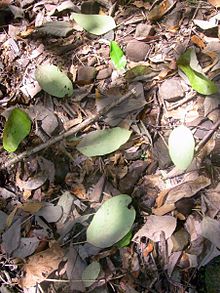
Back نثار (علم النبات) Arabic Töküntü (bitki) Azerbaijani Fullaraca Catalan Førne Danish Streu (Ökologie) German Hojarasca Spanish Varis Estonian Orbel Basque بستر گیاهی Persian Karike Finnish

Plant litter (also leaf litter, tree litter, soil litter, litterfall or duff) is dead plant material (such as leaves, bark, needles, twigs, and cladodes) that have fallen to the ground. This detritus or dead organic material and its constituent nutrients are added to the top layer of soil, commonly known as the litter layer or O horizon ("O" for "organic"). Litter is an important factor in ecosystem dynamics, as it is indicative of ecological productivity and may be useful in predicting regional nutrient cycling and soil fertility.[1]
- ^ Ochoa-Hueso, R; Delgado-Baquerizo, M; King, PTA; Benham, M; Arca, V; Power, SA (February 2019). "Ecosystem type and resource quality are more important than global change drivers in regulating early stages of litter decomposition". Soil Biology and Biochemistry. 129: 144–152. doi:10.1016/j.soilbio.2018.11.009. hdl:10261/336676. S2CID 92606851.
© MMXXIII Rich X Search. We shall prevail. All rights reserved. Rich X Search